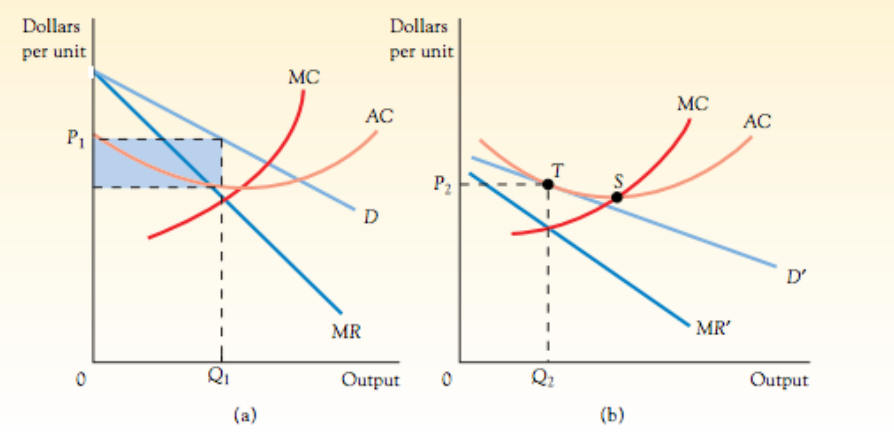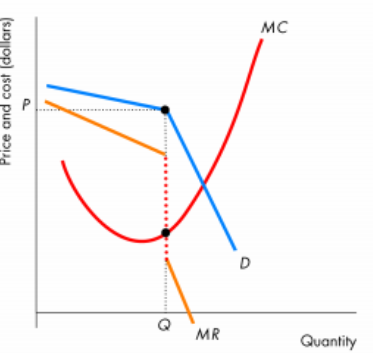Economists have differentiated among four different types of market competition: perfect and monopolistic competition, monopoly, and oligopoly (Collins 2012, p. 27). However, the dominant types among these are monopolistic competition and oligopoly, types that have some similarities, differences, advantages and disadvantages for potential clients.
Monopolistic Competition Versus Oligopoly
The structure of the market in the majority of industries balances among monopoly and perfect competition. In a market with perfect competition, there are a variety of firms, which are allowed to enter the market; an abundance of homogeneous products and the competition is centered on prices, quality of products, as well as their marketing. A pure monopoly, on the other hand, is characterized by the restrictive dominance of one producer of a certain product.
Tha balance between pure monopoly and competition are monopolistic competition and oligopoly. A market with monopolistic competition is similar in characteristics to the competition market although the products firms sell are differentiated rather than homogeneous. Oligopoly, on the other hand, is similar in its structure to pure monopoly because it involves a small number of big companies that produce either a differentiated or a homogeneous product (Browning & Zupan 2015, p. 355).
Monopolistic Competition Price and Output
Contrast to pure competition, a market characterised by monopolistic competition does not involve a homogeneous product. On the contrast, the products are differentiated which means that potential customers see differences in an array of similar products. For instance, Lucky Charms and Fruit Loops are differentiated items in a general array of breakfast cereals. Thus, customers differentiate between various types of cereal because they see differences in flavor, shape, nutritional value, etc.
An important step in understanding the market with monopolistic competition is to analyze the demand curve associated with a particular company because if it markets a differentiated product that has similar substitutes, such a company can be viewed as the one with monopolistic power. For example, assume that the market for leather jackets is a competitive monopoly (Browning & Zupan 2015, p. 356).
Figure 1 illustrates the demand for leather jackets of a particular company, J.Crew. The demand curve for the product depends on the variety of available jackets as well as the prices. When drawing a demand curve, it is assumed that there is a fixed number of companies that produce leather jackets. Due to the fact that the demand curve goes downwards, it is concluded that the price is higher than the marginal revenue. Thus, with these conditions, J.Crew charges the price P1 with the output of Q1. The shaded are in the graph illustrates the resulting profit.

As illustrated in the graph (a), in the short run a company that operates in monopolistic competition is able to earn an economic profit. However, when new companies enter the market (b), the demand curve D’ shifts down to reach the zero profit with the attainment of the long run equilibrium.
Oligopoly and the Kinked Demand Curve
Contrast to monopolistic competition the oligopoly market structure implies limits that prevent or restrict the entry of other businesses to the market. In the oligopolistic competition, small companies that are interdependent compete with each other. Interdependence implies that sudden changes in the actions of one firm can greatly affect the stability of another. A cartel is characterised by several companies working together in order to increase their economic profit through the reduction of their input.
Figure 2 illustrates the kinked demand curve model which implies that a company has a belief that if it increases the prices, there will be less competition, and, if it decreases the prices, there will be much more competition (Chapter 13: monopolistic competition and oligopoly 2008, p. 222).

Thus, a company is faced with the kinked demand curve that kinks at the current quantity and price of a product. This kink in the demand curve also causes the break in the MR curve. A single condition applies in this situation: the quality and prices of products remain the same if the MC curve is within the limits of the break. Thus, the disadvantage of the model is in it failing to illustrate what will happen if the firm’s belief about the increases and decreases in price is invalid.
Why Monopoly is Good for Consumers
In the long run, a company that operates in the monopolistic competition are usually positioned in such a way that allows them to use the economies of scale thought an abundance of resources. Thus, with a smaller competition on the market, a company can rapidly achieve a level of balance between low prices and high income. To simplify, a company-monopolist has an ability to offer cheaper services and products for the population by lowering the long-term marginal costs (Petru n.d., p. 3).
The second benefit of the monopoly when it comes to offering value to customers is directly related to the field of research and development. Because monopolistic companies obtain normal profit, they are able to invest in the sphere of research and development, which, in turn, leads to the reduction of costs for the company and subsequently reduction of the prices for customers. In addition, research and development lead to the production of higher-quality products as well as a larger variety of products for consumers to choose from (Petru n.d., p. 3).
Why Oligopoly is Bad for Consumers
The process of price establishment in an oligopolistic competition can be a major benefit for businesses, although, if the set prices are unrealistic, they become a potential disadvantage for consumers (Buzzle n.d., para. 15). Due to the restrictive access to the market, new companies cannot develop fully and make independent decisions they fail to provide high value and low for potential customers.
The concept of price discrimination also relates to the oligopolistic market it is widely used as a feature to exclude and alienate competitors (Perrot 2005, p. 17). Due to the fact that some companies in an oligopoly become too occupied with excluding competitors from the market, they provide lower-quality services for customers thus decreasing the value. Furthermore, the abnormal (excess) profits are the primary characteristics of an oligopoly; such profits mean that there is an existing incentive for other businesses to enter the industry.
The solution for abnormal profits in an oligopolistic business can be derived from the practices of research and development adopted my many monopolies. For instance, the abnormal profits earned by Apple, Inc. go directly to the research and development of new products, making sure that all disadvantages of a previously-released item are eliminated. Research and development of products can also aid at increasing the quality of products and reducing the prices thus providing more value to potential clients.
Reference List
Browning, E & Zupan, M. 2015. Microeconomics: theory and application, 12th edn, John Wiley & Sons, Hoboken, NJ.
Buzzle n.d. Advantages and disadvantages of oligopoly. Web.
Chapter 13: monopolistic competition and oligopoly. 2008. Web.
Collins, K. 2012. An introduction to business. Web.
Long and short-run Monopolistic Competition. n.d. Web.
Oligopolistic Competition. n.d. Web.
Perrot, A. 2005. Towards an effects-based approach of price discrimination. Web.
Petru, C. n.d., Monopoly: advantages and disadvantages. Web.
